After a long winter, the chirping of the birds is such a nice sign that spring is coming. But when you start finding chunks taken out of your tomatoes, that excitement can quickly turn to anger.
Was it birds, and do birds even eat tomatoes?
Do Birds Eat Tomatoes
Yes, birds do eat tomatoes. Tomatoes are very juicy fruits, so if a bird is thirsty, it might be more likely to attack your tomato garden to quench their thirst.
Keeping a bird bath or other source of water nearby can help mitigate this. While they generally won’t eat tomato leaves, they definitely will eat the fruit.
Which Birds Eat Tomatoes
Some types of birds are more likely to eat tomatoes than others. These ones have been known culprits of tomatoes in the garden:
- Cardinals
- Sparrows
- Mockingbird
- Blue Jay
- Brown Thrush
- Quail
- Pigeons
- Grackles
- Starlings
- Blackbirds
- Cowbirds
If you’ve been leaving out food for the birds in your backyard, i.e. with a bird feeder, you might be more likely to have this issue because they are already in your area knowing food is around.
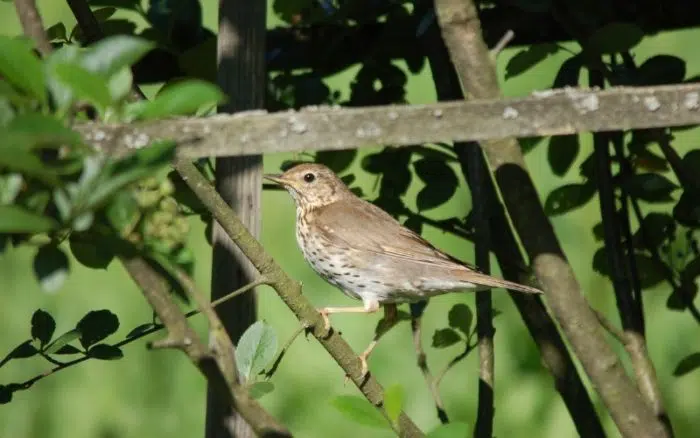
How to Tell if a Bird is Eating Your Tomatoes
There are a few telltale signs birds are destroying your tomatoes.
Chunks or Holes in Tomatoes
Birds have beaks as you know, so they use these sharp beaks to make holes in the plant and eat the insides. Most of the fruit will be okay, but it will almost look like a kid came over and took a couple of bites out of your tomatoes.
In the case of cherry tomatoes, they might end up knocking the fruit to the ground because it’s more delicate. But, they won’t swallow them whole, so you’ll still see small puncture marks have been removed.
Bird Droppings
Birds will leave their marks nearby as well. Since birds like to perch, usually your trellis or T-posts are a great place for that. While they’re there, they might make a quick snack of your tomatoes.
Check for bird droppings nearby your eaten plants, and this might provide a good clue as to who is eating your tomatoes.
7 Ways to Keep Birds From Eating Your Tomatoes
There are quite a few good ways to help keep the birds off your tomato plant and from eating your ripening tomatoes.
1. Bird Netting
Bird netting is a great way to keep birds off of your tomato plants. The netting makes it very hard for animals, especially birds and deer from eating the tomato fruits.
Bird netting is great because it can be reused each year, so it’s something you can keep in your garden tool belt for years.
Garden netting helps keep animals from ravaging your garden:
- Deer
- Birds
- Squirrels
- And more
Spread netting out over the top of your plants to keep them from
2. Motion Activated Sprinkler
This is my favorite option to protect tomato plants. A motion-activated sprinkler works on a wide variety of garden pests, including birds, deer, rabbits, and raccoons.
I tested it out and it works! Here is the motion-activated sprinkler in action in my garden:
Essentially, the sprinkler has sensors on the front, and once it senses movement, it will spray water at its victim. Beware, this works on humans too, so don’t forget to turn it off before you go check on your tomato plants to see if you have ripe tomatoes.
While it may seem cruel, water isn’t going to hurt birds, but it will definitely scare them and make them rethink the next time they go near your fresh vegetables.
A motion activated sprinkler works wonders for keeping animals (and people!) out of your yard. It sprays intermittently as it detects continuous motion so animals won't get used to the timing of it.
3. Hanging CDs
Have some extra DVDs or CDs hanging around? These can be a good option for helping keep birds out of the garden. Birds get scared easily by shiny, quickly moving objects, and hanging CDs from garden twine or string is a great way to imitate those movements.
Hang shiny objects like these around the garden on a piece of string. This will allow them to sway in the wind and create shiny movements to deter birds.

4. Scarecrows and Fake Owls
Most birds are going to be scared of a bird of prey like an owl. Keeping a fake owl around can be a helpful way to divert birds from hanging around your raw tomatoes.
Fake owls are great for keeping many animals out of the garden, including squirrels, deer, birds, and more.
5. Pick Your Tomatoes Early
Most animals that eat tomatoes go after them when they are red, ripe, and ready to be eaten. But did you know that you can pick tomatoes a few days before they are fully riep to avoid this extra competition?
I like to pick tomatoes during the breaker stage, which is when they are starting to turn pink (or yellow if you’re growing yellow tomatoes). They are still going to ripen, but that will be done safely on your kitchen counter.
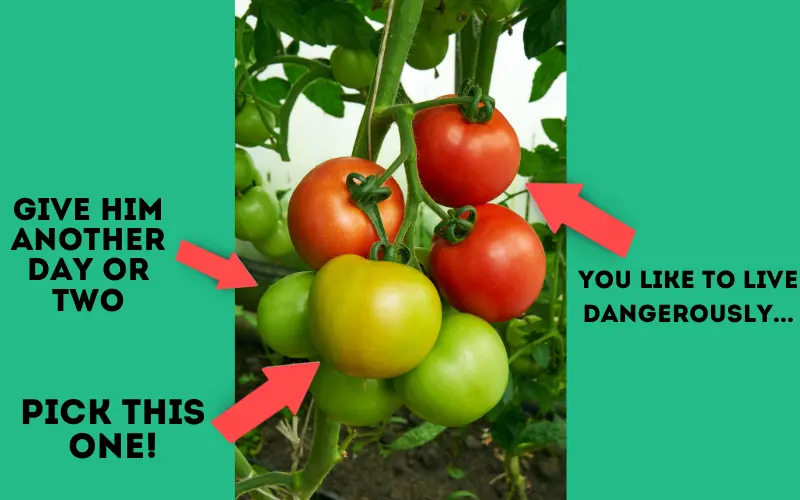
Related: When to Pick Tomatoes and Why Harvesting Them Early Can Increase Your Harvest
While this isn’t a catchall as some birds like sparrows have been known to eat unripe and even green tomatoes, it can definitely help you keep more of your harvest.
6. Birdbaths
As I mentioned above, tomatoes often get eaten because they are juicy and contain a ton of water content. The birds might just be thirsty!
Placing a birdbath nearby (but not too close to your garden!) can help them get a drink without destroying your crops.
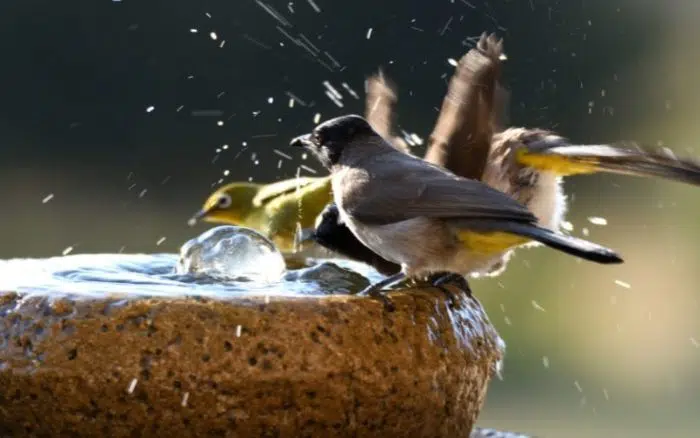
7. Bird Feeders
On the same note, if a bird is hungry, it might be nice to give them a meal…on the other side of your house! 🙂
This one is a little questionable because if a bird comes to your garden or backyard because you always have food out, they might wander around and end up eating some of your gardens. So, you’ll have to decide if this is a good idea or not, but I love being able to watch birds in the backyard every morning!
What Do Birds Eat?
Birds have a pretty varied diet when it comes to feeding in nature. While they mostly go after seeds and grain, hungry birds will eat fruits too.
Birds have been known to eat:
- Seeds (sunflower seeds
- Nuts
- Berries and fruit (including your delicious tomatoes)
- Insects & Bugs (they eat insects like worms, grubs, tomato hornworms, and mosquitos)
While those are their main targets, if they’re hungry enough they will get creative.
Birds do eat tomatoes, but there are a number of methods you can use to help keep them from destroying your crop. Bird netting and harvesting tomatoes early are two super effective methods that I recommend you try out!


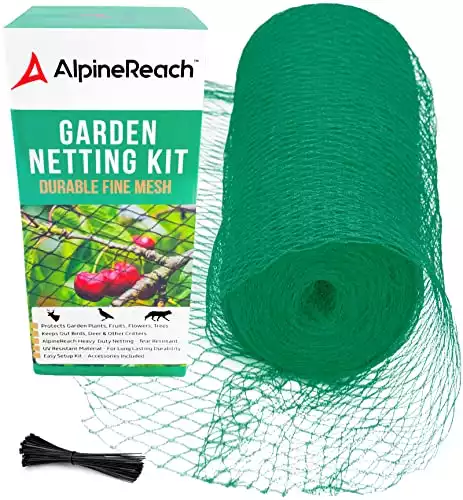

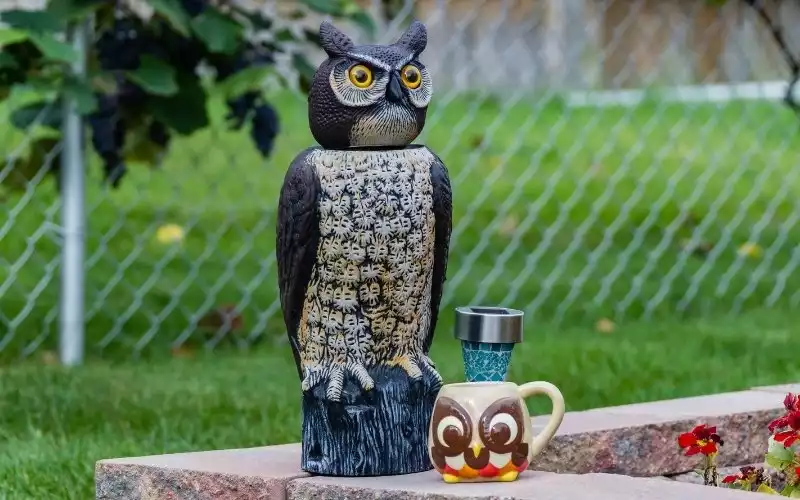

I used to have terrible problems keeping squirrels, rats, and birds from eating my pomegranates, avocadoes, grapefruit, and tomatoes. I decided to try using aluminum foil, by wrapping the foil around the fruit. It doesn’t have to completely enclose the fruit – just over the top and sides at the most. I like the food service pop-up foil sheets. I have absolutely no more issues with any critters eating my fruit. None of the fruits I listed need the sun hitting them to ripen and I pick tomatoes just after the breaking stage to ripen indoors anyway. AF is not practical with many fruits that are hard to get to or are in large quantities, like with large trees, but dwarf varieties or pruned to lower heights lends itself well to this method. With tomatoes you can either wrap a single tomato all by itself or loosely wrap over the top of a cluster to keep all sorts of critters from bothering the fruit. They just hate the stuff and don’t know what to do with it.